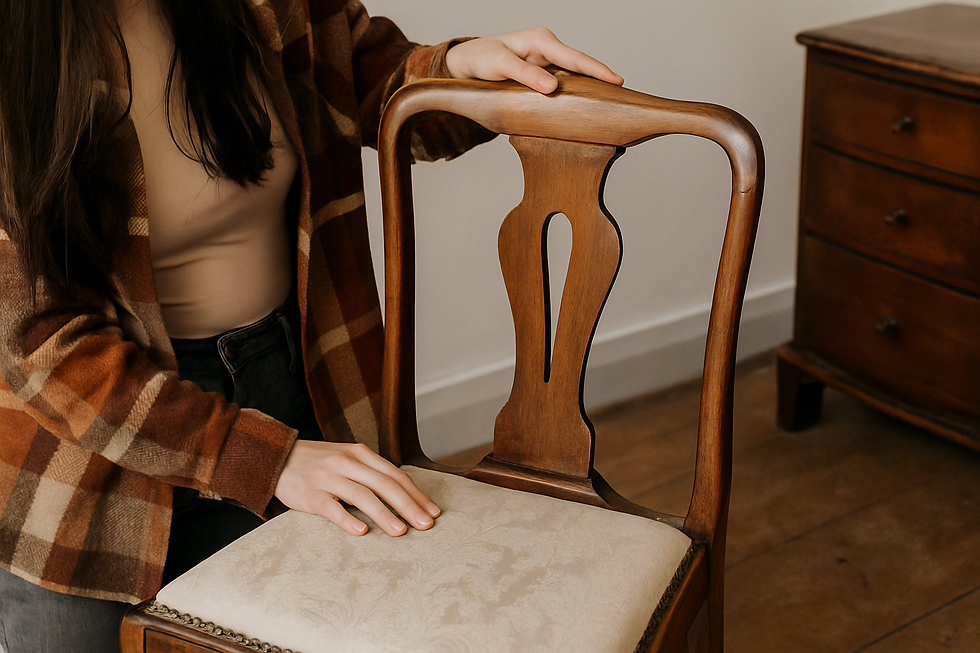5 things to look for when buying second-hand furniture (that most people miss)
- Emily

- Jun 27
- 3 min read
Updated: Jul 3

Buying second-hand furniture is basically treasure hunting – except your map is Facebook Marketplace, and the 'X' is a blurry photo captioned “antique?” (Bonus tip: if they’re questioning it, it probably isn’t. Maybe vintage – maybe.)
Done right, it’s a brilliant way to save money, reduce waste, and find beautiful pieces with real character. But it helps to know what you're looking for (and what to avoid). Here are five things I always check – and most people don’t.
1. Look underneath (yes, actually underneath) and on the back panels
Flip the table. Tilt the chair. Take out a drawer and check the underside. Get on the ground and peer under the chest of drawers like you’re hunting for mice.
You’re looking for:
A maker’s mark or stamp (can indicate quality or collectability – we don’t usually paint these pieces, but they can be restored)
The type of joinery (dovetails = good, staples = eh)
Clues as to whether it’s solid wood or veneer (I should probably write a separate post on this)
Any uninvited guests like mould or woodworm (fun for absolutely no one)
2. Give it a little sniff
I know. Weird. But your nose is a powerful tool.
Short version: furniture that’s lived in a damp garage or around heavy smokers can hold smells that that no amount of Febreze will fix. If it smells musty, sour, or generally unpleasant, think carefully.
Long version: it's not impossible to remove odours – but it can be a big, frustrating job, especially for beginners. Vinegar is your best friend here. It’s a brilliant all-round cleaner and does a great job on surface smells. If you’re painting, Zinsser BIN primer is stain- and odour-blocking and fantastic for truly offensive pieces – but it’s oil-based (a.k.a not planet-friendly), not fun to work with, and a nightmare to remove if you later want to strip the piece. In any case, start with warm water, washing up liquid, and a microfibre cloth (squeeze out excess water). Wash until the water in your bucket is clear – trust me.
3. Open and close everything
Drawers that stick. Doors that sag. Hinge squeaks loud enough to summon spirits. These are clues.
Sometimes it’s a quick fix. Sometimes it’s structural. Be gentle (it’s not yours yet!) but be thorough. Make sure everything opens and closes smoothly – or at least know what the issues are and whether you’re willing to fix them.
4. Check (and double-check) the proportions
It’s so easy to fall in love with a photo. But that "perfect" sideboard? It's actually the size of a small boat. That dainty Victorian chair? Ideal – if your thighs are the circumference of a breadstick.
Always ask for or take dimensions. Then map it out in your space. Use tape on the floor. TRUST ME. I include dimensions in all my listings – but even then, it’s surprisingly common for people to show up and say, “Oh no… it’s too big / small / tall / short.” If I had a penny for every time that happened, I’d be rich and unreachable 😁
5. Feel the finish
Run your hands over it. Are there deep scratches, bubbling varnish, or flaking paint?
Surface flaws aren’t a dealbreaker – they’re often fixable – but they do affect how much time, energy, and money you’ll need to invest. Even if you’re not planning to refinish it yourself (👋 hi, I know someone), factor in the labour: more work = more ££s.
Final thought: second-hand furniture is truly a joy. It has stories and potential – you just need to know how to choose wisely.
If you’ve fallen for a piece but the drawers stick, a leg’s fallen off, and it smells a little bit too much like cats… you know where to find me. Tried to tackle it yourself and realised you’re in too deep? Breathe. I’m still here 😊





Comments